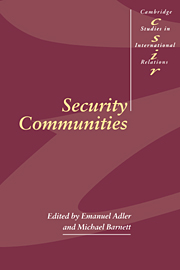Book contents
- Frontmatter
- Contents
- Notes on contributors
- Acknowledgements
- Part I Introduction and theoretical overview
- Part II Studies in security communities
- 3 Insecurity, security, and asecurity in the West European non-war community
- 4 Seeds of peaceful change: the OSCE's security community-building model
- 5 Caravans in opposite directions: society, state and the development of a community in the Gulf Cooperation Council
- 6 Collective identity and conflict management in Southeast Asia
- 7 An emerging security community in South America?
- 8 Australia and the search for a security community in the 1990s
- 9 The United States and Mexico: a pluralistic security community?
- 10 No fences make good neighbors: the development of the US-Canadian security community, 1871–1940
- 11 A neo-Kantian perspective: democracy, interdependence and international organizations in building security communities
- Part III Conclusions
- Index
- CAMBRIDGE STUDIES IN INTERNATIONAL RELATIONS
9 - The United States and Mexico: a pluralistic security community?
Published online by Cambridge University Press: 30 October 2009
- Frontmatter
- Contents
- Notes on contributors
- Acknowledgements
- Part I Introduction and theoretical overview
- Part II Studies in security communities
- 3 Insecurity, security, and asecurity in the West European non-war community
- 4 Seeds of peaceful change: the OSCE's security community-building model
- 5 Caravans in opposite directions: society, state and the development of a community in the Gulf Cooperation Council
- 6 Collective identity and conflict management in Southeast Asia
- 7 An emerging security community in South America?
- 8 Australia and the search for a security community in the 1990s
- 9 The United States and Mexico: a pluralistic security community?
- 10 No fences make good neighbors: the development of the US-Canadian security community, 1871–1940
- 11 A neo-Kantian perspective: democracy, interdependence and international organizations in building security communities
- Part III Conclusions
- Index
- CAMBRIDGE STUDIES IN INTERNATIONAL RELATIONS
Summary
Although Karl W. Deutsch and his colleagues invoked the USA — Mexican relationship in their study of pluralistic security communities, bilateral relations between the United States and its southern neighbor have fallen far short of a relationship that rests on trust and common identity. From Mexico's independence through its revolution in the early twentieth century, the USA intervened repeatedly in Mexico. American acquiescence in Lazaro Cardenas′ expropriation of Dutch, British and American oil companies in 1938 was a turning point and crucial test for Franklin D. Roosevelt's noninterventionist Good Neighbor Policy. During World War II, the two countries crossed the threshold of a loosely coupled security community, initiating a fifty-year period during which both sides have enjoyed “dependable expectations of peaceful change.” With the end of the war, however, the incentives for close cooperation dissipated and bilateral relations became less institutionalized and more ad hoc.
The signing of the North American Free Trade Agreement (NAFTA) opened a new era of cooperation and institution building. Nonetheless, collaboration between the two countries remains segmented and the extent of mutual confidence limited. In the USA, both the substantive content and dispute-settlement procedures of the NAFTA reflected quite substantial distrust of Mexico. Despite greater economic cooperation - some of it ad hoc, and crisis-driven - the 1980s produced heightened American concerns over drug trafficking and the stability of Mexico's dominant-party system. Bilateral conflict over immigration deepened, contributing to the revival of American nativism.
- Type
- Chapter
- Information
- Security Communities , pp. 295 - 332Publisher: Cambridge University PressPrint publication year: 1998
- 7
- Cited by

